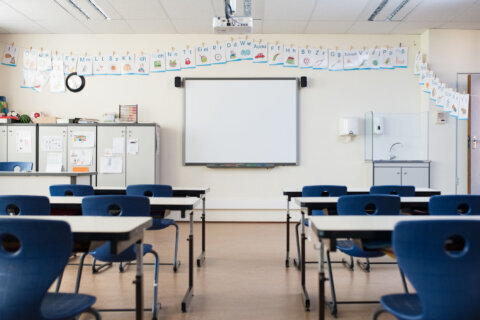In the summer of 2021, some teachers in Loudoun County, Virginia, reported major gaps in students’ skills after pandemic-induced school closures.
At the same time, a significant amount of research detailing the benefits of the Science of Reading, a literacy approach that emphasizes phonics, was released.
Before the 2021-22 school year started, first grade teachers at Catoctin Elementary School in Leesburg spent hours collaborating to determine how to best meet students’ needs, according to Jennifer Hartmann, the school-based instructional facilitator, and created a plan for how to approach teaching reading.
Kindergarten, first and second grade teachers were “astounded” by the progress students had made after the switch to a phonics program, Hartmann said. Last spring, the school reported a 15% decrease in students flagged by the county’s diagnostic literacy assessment, compared to fall 2021.
Now, all Loudoun County elementary schools are using University of Florida Literacy Institute (UFLI) Foundations as a core phonics program this year.
“We knew it was a little bit risky,” said Rita Welsh, one of the Catoctin teachers who helped the school implement the change. “But we felt very strongly about what we saw happening with all of the research.”
Under the phonics-based approach, students practice skills that they previously learned, and as a result, “we are seeing that students can read and spell more sophisticated words than we have seen in the past,” teacher Rosemary Malayil said.
Students, Malayil said, get to practice with vowels, spelling and reading “with words in both isolation and in context.” They also practice reading passages and writing sentences.
Each lesson, according to Walsh, has eight steps and is taught over a two-day span. One type of exercise helps students blend sounds together to construct words.
“It has been incredibly exciting to see the significant impact on student learning after implementing phonics-based literacy instruction,” Walsh said. “The skills students are learning provide a better opportunity for all students to learn how to read and write.”
Students who have been taught using the emphasis on phonics have seen positive results, the teachers said during a school board meeting last week.
In the fall of 2021, when first graders started getting exposed to some Science of Reading materials, 22% of kindergartners, 31% of first graders and 37% of second-graders were identified as needing extra support. By last spring, it was 15%, 16% and 16%, respectively.
Gains were also reported on the screener’s spelling subtest. Ninety-percent of kindergarten through second-graders met the benchmark for the spelling subtest, and 21% of first-graders last spring met the “high” benchmark for the screening test, which Hartmann said “means the state has determined that their scores demonstrate they are no longer at risk.”
“What we’re realizing is now that they know how to spell words, their writing makes sense,” Malayil said.
Both Malayil and Walsh said preparing for the revamped lessons is time-consuming, but the benefits are clear.
“The results have been quite impressive,” Malayil said.








